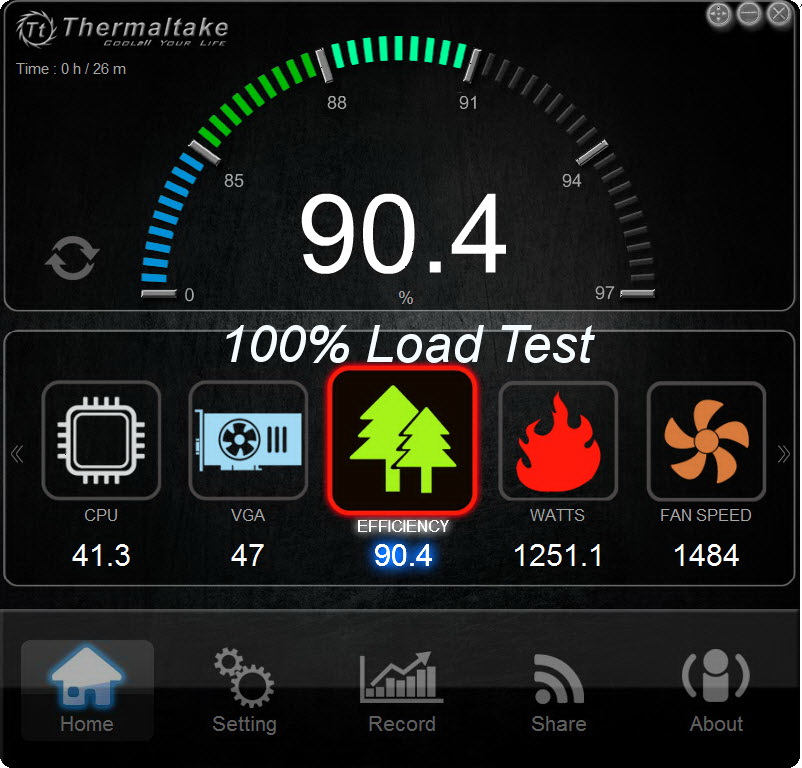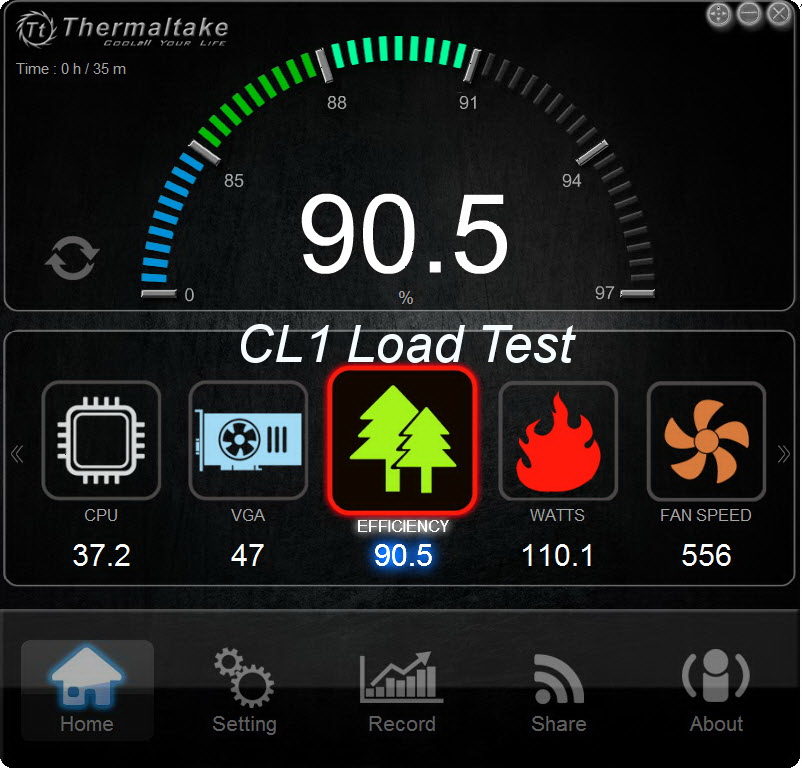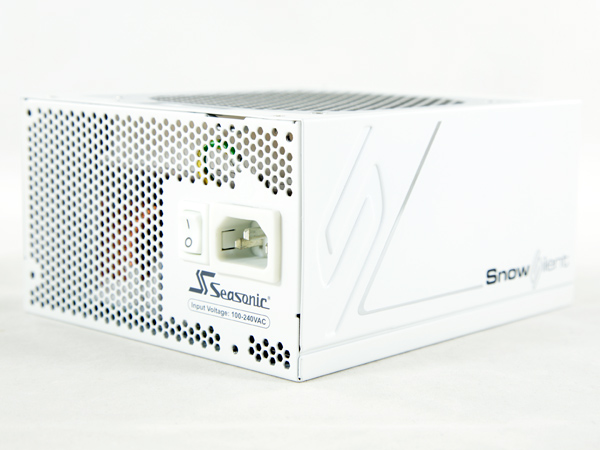Thermaltake Toughpower DPS G RGB 1250W PSU Review
Thermaltake recently released a new flagship Titanium-class PSU, the Toughpower DPS G RGB with 1250W max. power. Besides an RGB LED fan, this unit also features high performance, modular cabling, and compatibility with the SPM cloud platform.
Why you can trust Tom's Hardware
Load Regulation, Hold-Up Time And Inrush Current
To learn more about our PSU tests and methodology, please check out How We Test Power Supply Units.
Primary Rails And 5VSB Load Regulation
Load Regulation testing is detailed here.








Hold-Up Time
Our hold-up time tests are described in detail here.







The hold-up time easily meets the ATX spec's requirements, and the power-good signal drops before the rails go out of spec. There is nothing more for us to ask; CWT does a great job.
Inrush Current
For details on our inrush current testing, please click here.


The measured inrush current is very low given this unit's increased capacity and large bulk caps.
Load Regulation And Efficiency Measurements
The first set of tests reveals the stability of the voltage rails and the PSU's efficiency. The applied load equals (approximately) 10 to 110 percent of the maximum load the supply can handle, in increments of 10 percentage points.
Get Tom's Hardware's best news and in-depth reviews, straight to your inbox.
We conducted two additional tests. During the first, we stressed the two minor rails (5V and 3.3V) with a high load, while the load at +12V was only 0.1A. This test reveals whether a PSU is Haswell-ready or not. In the second test, we determined the maximum load the +12V rail could handle with minimal load on the minor rails.
| Test # | 12V | 5V | 3.3V | 5VSB | DC/ACWatts | Efficiency | Fan Speed | Fan Noise | Temps In/Out | PF/ACVolts |
|---|---|---|---|---|---|---|---|---|---|---|
| 1 | 8.576A | 1.975A | 1.999A | 0.990A | 124.72 | 91.08% | 552 RPM | 22.5 dB(A) | 37.91°C | 0.983 |
| 12.025V | 5.065V | 3.299V | 5.048V | 136.94 | 39.96°C | 115.2V | ||||
| 2 | 18.208A | 2.959A | 2.999A | 1.184A | 249.56 | 93.28% | 552 RPM | 22.5 dB(A) | 38.62°C | 0.988 |
| 12.012V | 5.063V | 3.299V | 5.044V | 267.55 | 41.21°C | 115.1V | ||||
| 3 | 28.221A | 3.457A | 3.513A | 1.385A | 374.66 | 93.64% | 552 RPM | 22.5 dB(A) | 39.26°C | 0.992 |
| 11.998V | 5.061V | 3.298V | 5.040V | 400.09 | 42.34°C | 115.1V | ||||
| 4 | 38.234A | 3.953A | 3.999A | 1.584A | 499.28 | 93.35% | 552 RPM | 22.5 dB(A) | 40.54°C | 0.992 |
| 11.982V | 5.059V | 3.298V | 5.035V | 534.87 | 44.49°C | 115.2V | ||||
| 5 | 47.924A | 4.948A | 5.000A | 1.784A | 624.23 | 92.84% | 552 RPM | 22.5 dB(A) | 41.44°C | 0.997 |
| 11.972V | 5.057V | 3.298V | 5.030V | 672.37 | 46.36°C | 115.2V | ||||
| 6 | 57.641A | 5.933A | 6.000A | 1.984A | 749.15 | 92.21% | 552 RPM | 22.5 dB(A) | 43.03°C | 0.998 |
| 11.960V | 5.056V | 3.299V | 5.028V | 812.42 | 48.87°C | 115.2V | ||||
| 7 | 67.371A | 6.926A | 7.000A | 2.185A | 873.89 | 91.47% | 820 RPM | 29.6 dB(A) | 44.55°C | 0.999 |
| 11.946V | 5.054V | 3.299V | 5.025V | 955.36 | 51.24°C | 115.1V | ||||
| 8 | 77.156A | 7.913A | 7.999A | 2.388A | 998.76 | 90.56% | 1048 RPM | 34.8 dB(A) | 45.64°C | 0.999 |
| 11.929V | 5.053V | 3.300V | 5.020V | 1102.93 | 52.82°C | 115.2V | ||||
| 9 | 87.368A | 8.421A | 8.516A | 2.389A | 1123.60 | 89.85% | 1316 RPM | 40.9 dB(A) | 46.89°C | 0.998 |
| 11.915V | 5.050V | 3.299V | 5.019V | 1250.59 | 54.58°C | 115.1V | ||||
| 10 | 97.394A | 8.918A | 9.004A | 2.993A | 1248.60 | 89.02% | 1484 RPM | 42.4 dB(A) | 48.55°C | 0.997 |
| 11.899V | 5.049V | 3.299V | 5.005V | 1402.61 | 57.03°C | 115.2V | ||||
| 11 | 108.035A | 8.919A | 9.008A | 2.994A | 1373.37 | 88.11% | 1556 RPM | 43.8 dB(A) | 50.14°C | 0.997 |
| 11.882V | 5.047V | 3.297V | 5.004V | 1558.76 | 59.31°C | 115.2V | ||||
| CL1 | 0.101A | 12.011A | 12.005A | 0.000A | 101.98 | 86.33% | 556 RPM | 22.5 dB(A) | 48.09°C | 0.980 |
| 12.013V | 5.068V | 3.323V | 5.091V | 118.13 | 55.16°C | 115.2V | ||||
| CL2 | 104.097A | 1.003A | 1.003A | 1.001A | 1252.77 | 89.46% | 1488 RPM | 42.4 dB(A) | 50.51°C | 0.997 |
| 11.906V | 5.048V | 3.284V | 5.033V | 1400.43 | 59.48°C | 115.2V |
The +12V rail's load regulation is decent, although nowhere near the reigning Corsair AX1500i. At least the minor rails offer super-tight load regulation, with the 3.3V rail registering an amazingly low deviation of only 0.06%! This means there is practically no voltage drop on the 3.3V rail during our tests. If the +12V rail featured tighter load regulation then the TPG-1250D-T would match the mighty AX1500i in this discipline.
We didn't engage silent mode through the DPSApp, so the fan is active from our 10% load test. It's inaudible, though, since it spins at a very low speed. The fan's noise increases during the 70% load benchmark, reaching close to 35 dB(A) with 80% load and exceeding 40 dB(A) above 90% load. All in all, the PSU remains quiet, even at very high ambient temperatures and under increased loads.
With 10% load, the 80 PLUS Titanium's 90% efficiency requirement is easily satisfied. Same goes for the 20% load. However, in the middle of its range, the PSU falls away from its 94% goal, dropping below 93%. Finally, under full load, the TPG-1250D-T doesn't manage to stay close to 90% as the Titanium certification requires. This is something we'd expect since the 80 PLUS organization tests at only 23°C, while we apply much higher operating temperatures.
DPSApp Screenshots
You will find several screenshots of the DPSApp software below.













Up to the 30% load test, reported efficiency comes close to what our lab-grade equipment measures. Under higher loads, the DPSApp provides inaccurate information that gets worse as the load increases.
A temperature warning popped up when the program noticed we were pushing the PSU too hard. This time we didn't get any fan failure warnings like the ones we saw during our TPG-1200D-P review.
There is an extra menu in the DPSApp, which allows you to set the color and the brightness of the PSU's LED fan.
Current page: Load Regulation, Hold-Up Time And Inrush Current
Prev Page A Look Inside And Component Analysis Next Page Efficiency, Temperature And Noise
Aris Mpitziopoulos is a contributing editor at Tom's Hardware, covering PSUs.
-
GPUEnthusiast I think those cables look straight ugly with three colors like that. In a windowed case, you won't even notice they're sleeved and it will instead look like an old style power supply with the rainbow wires, just really thick. I think they should stick with black and red, or just black. That yellow is faded too much and looks like it's for a banana themed build.Reply -
g-unit1111 Maybe it's me but I fail to grasp how an RGB ring on a PSU adds to it. Especially since most cases have bottom-mounted PSUs these days.Reply -
jimmysmitty Reply18420891 said:Maybe it's me but I fail to grasp how an RGB ring on a PSU adds to it. Especially since most cases have bottom-mounted PSUs these days.
It's all about them ground effects brah!!!!!
I agree though. Unless you have a very open bottom, most do not since most have a dust filter, it wont really show. I would expect a LED logo instead. -
turkey3_scratch This is a really great power supply! The transient response performance is top-notch. I really like it. The only thing I wish is for it to be a multirail design.Reply -
basroil Almost something I could recommend, if not for that horrible double line frequency oscillation in the 12V. I would have expected a digitally controlled system to be able to remove simple harmonics like that. Perhaps their controller algorithm isn't all that great?Reply -
powernod I was anxiously expecting this review due to CWT's new CST platform.Reply
Just like Aris said at the end of his review, i'm expecting to see how the smaller wattage models will perform.
The 1250 watt model seems like an excellent unit, and the only thing i disliked is the small output from the smaller rails ( 20A @5V &3.3V / 15A @5VSB ).
P.S. Once again, an excellent review from Aris!!




